Homemade pie crusts are about a thousand times more flavorful, flaky, and tender than the store-bought kind. It takes a little bit of extra work to get a perfect pie crust, but it absolutely does not need to be as intimidating as it may seem.
Until the dough comes together in a cohesive ball, it seems like something has gone wrong. Not to mention all of the frustrations when pie dough shrinks or loses its shape after baking. I’ve factored in as many potential pie crust woes into this recipe to make it as foolproof as possible.
I actually completely overhauled my pie crust recipe in 2020 to make it even more tender and flaky. I took a bunch of feedback I’d received over the years from readers to improve the recipe and I’m SO happy with the results. Take a look at just how FLAKY:
I spent weeks testing, experimenting, and researching different pie dough methods, tips, and tricks. Some worked, others didn’t.
I’m sharing a ton of tips that truly work in this post, so let’s go ahead and get right into the juicy stuff. (Or should I say flaky stuff?)
How to Make the Best Ever Pie Crust
For Flaky Pie Crust, Keep Everything COLD, Especially Your Butter
If your kitchen is above 73°F, you can refrigerate all of your ingredients and equipment including your bowl, rolling pin, and pie plate until it’s between 65-70°F (dip an instant-read thermometer into your flour to gauge the temperature). If it’s a hot day, or you have hot hands, you’re probably better off making your pie dough in a food processor.
If your kitchen is warm, fill freezer bags with ice and a little water and set them on your work surface for 10 minutes to chill it before rolling out your pie dough. This will prevent the butter from becoming greasy as you work with the dough.
Pea-Sized vs. Large Chunks of Butter in Pie Dough
- The general rule of thumb is that smaller pieces of butter will result in a more mealy textured crust that holds up better to custard fillings.
- Larger chunks of butter will yield a flakier crust better suited for fruit fillings. Larger chunks also run the risk of creating pools of butter as your pie dough bakes.
- Overall, the differences can look relatively minor from a visual perspective once the crusts are baked.
- If you don’t have a ton of pie dough experience or confidence, I’d recommend small pieces of butter. It makes the dough much easier to work with!
- Take a look at what a difference it makes to use pea-sized vs. large chunks of butter in pie crust:
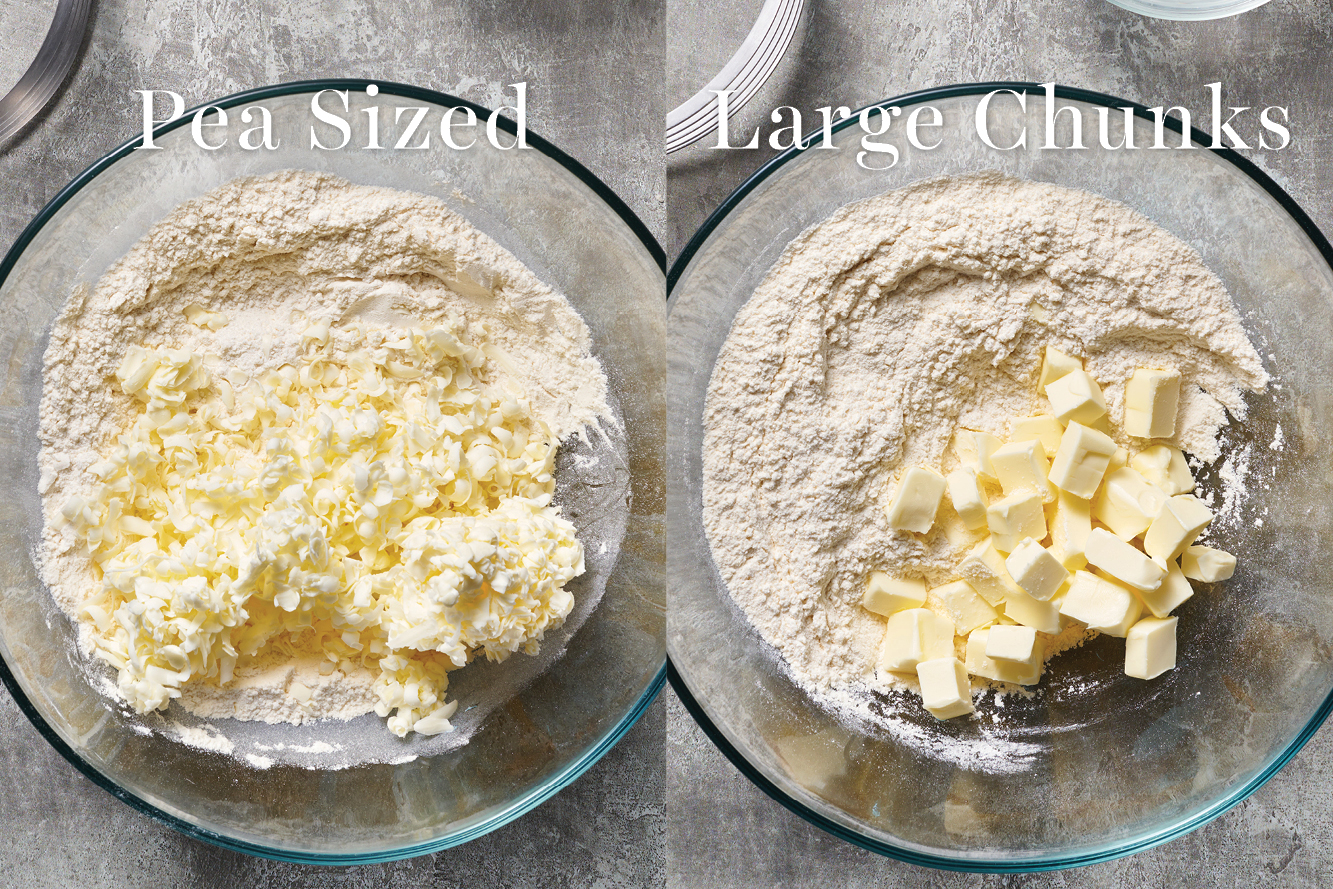

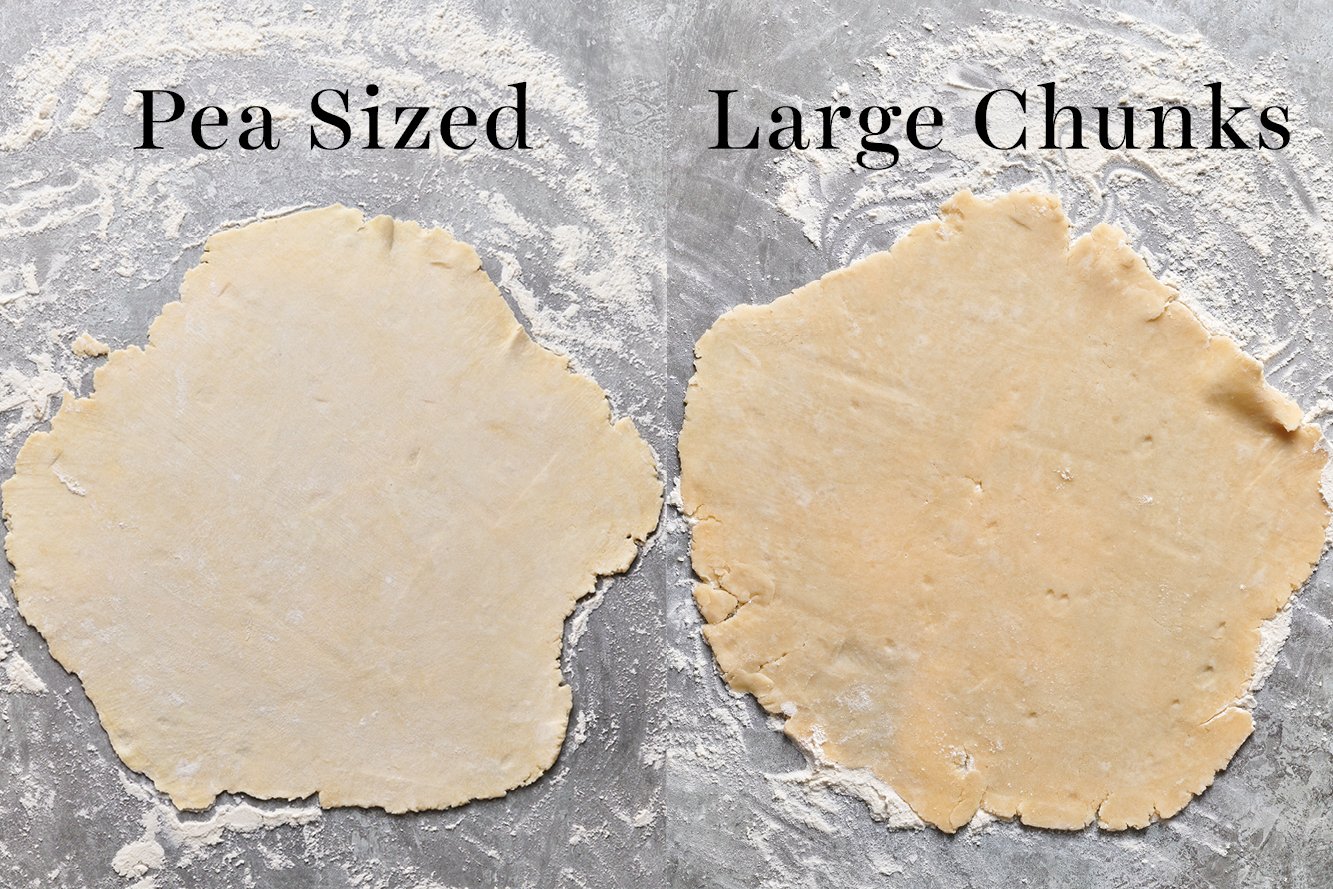
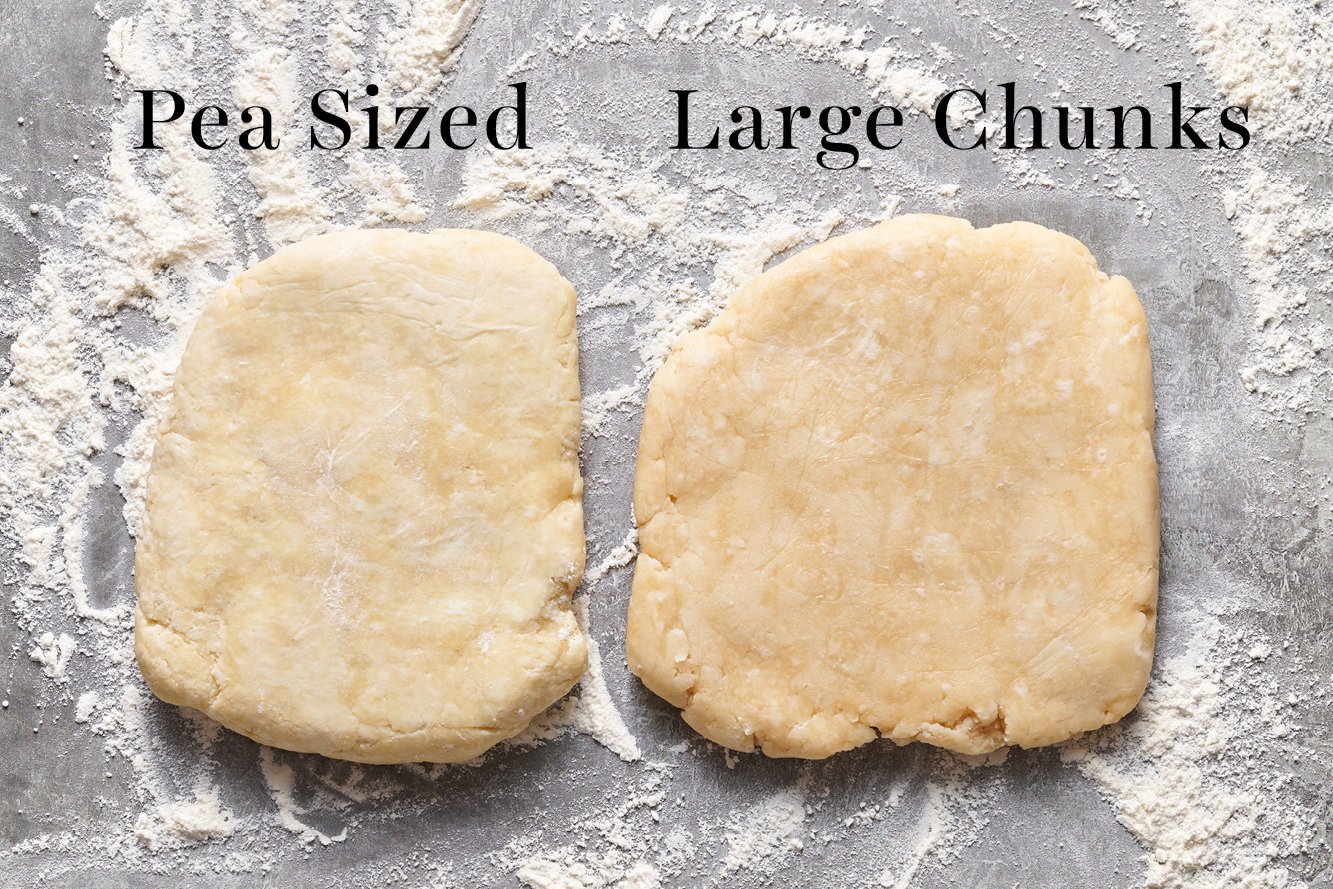
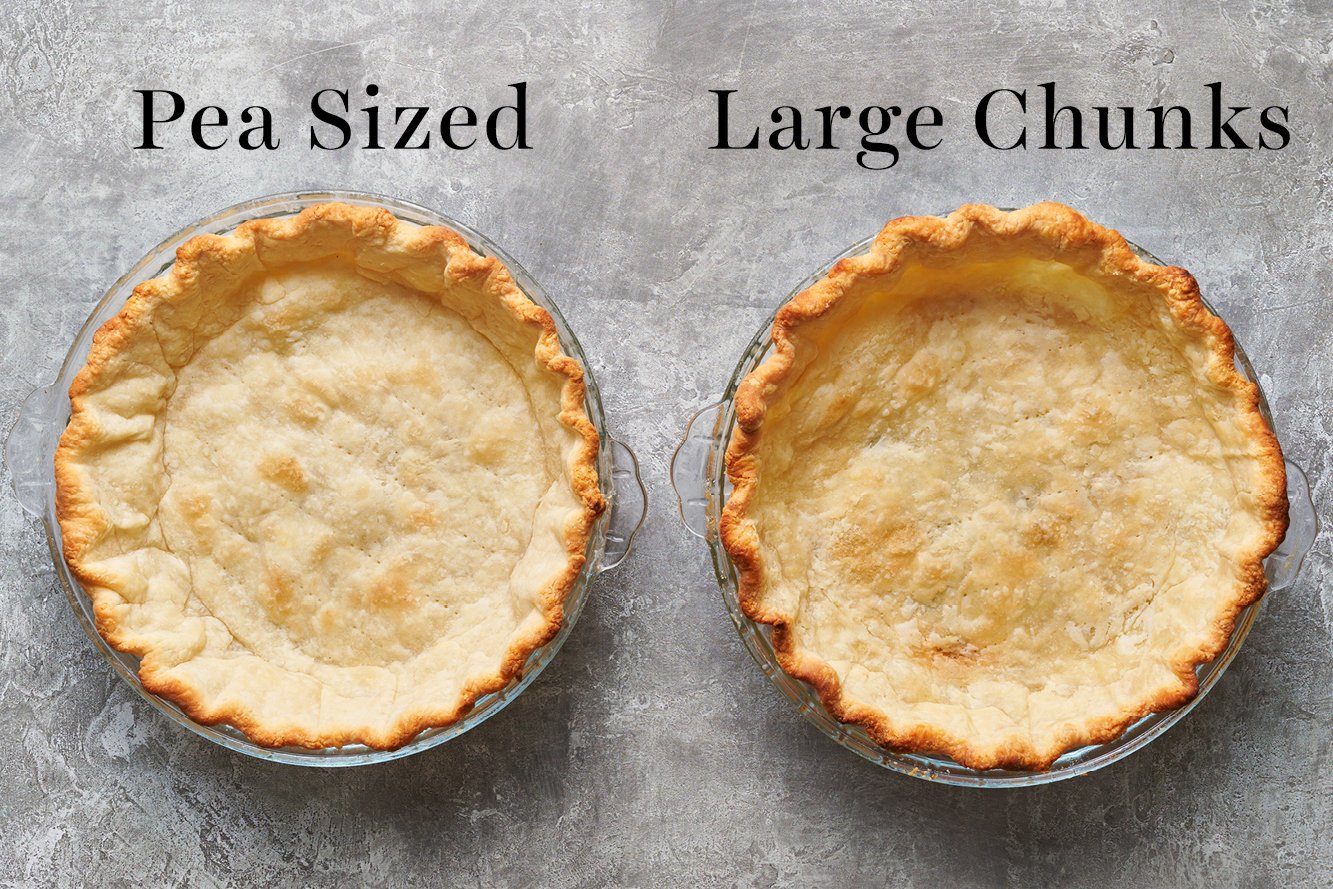
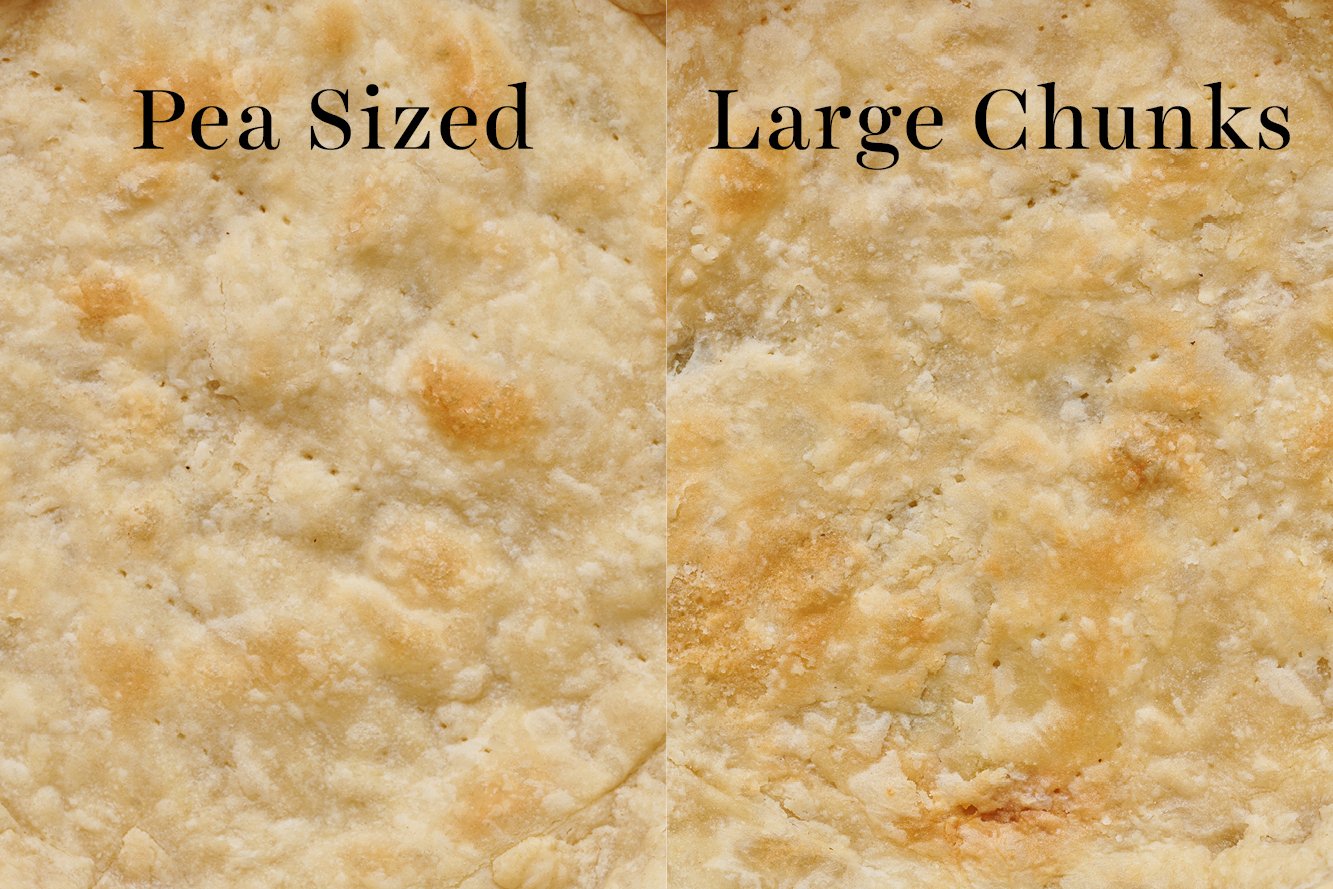
Cut the Butter Into Small Uniform Pieces
It should take just a couple of minutes to cut the butter into the flour mixture so you don’t risk the butter getting too hot. For this reason, it’s helpful to start out with pieces of butter that are already small in size. I’ve included several options for processing the butter below. My personal favorite is to grate it like cheese!
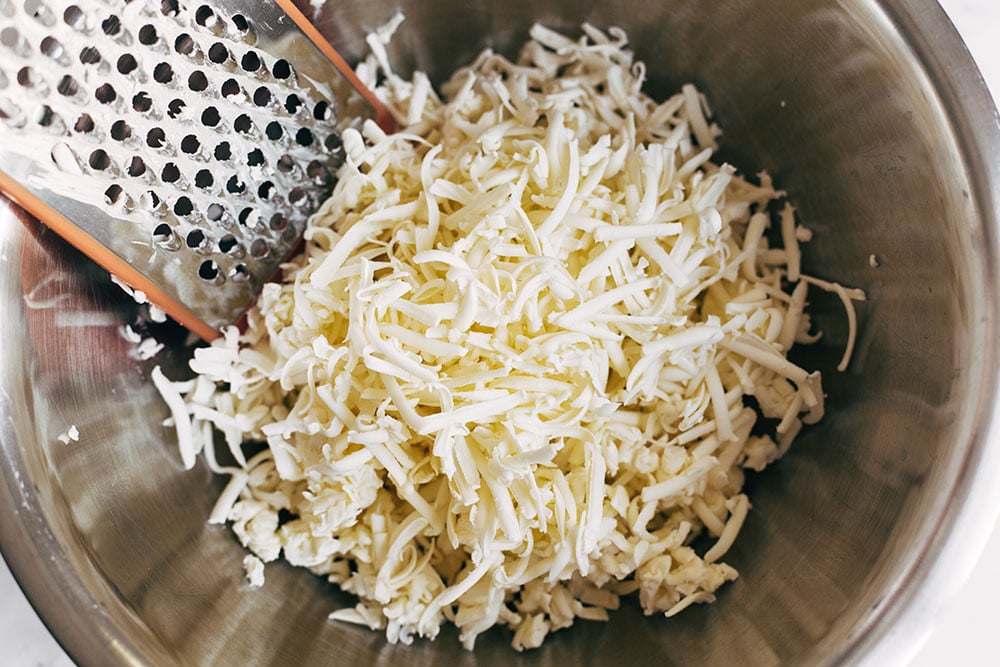
Method 1: Grater or Knife
Take your butter and freeze it for about 10 minutes, or until it’s super cold and firm. Using the large holes on a grater, literally grate the butter like cheese. If you have it, you can use the grater attachment on your food processor, but otherwise use the large holes on a box grater. Return the grated butter to the freezer for another 10 minutes until it’s firm before adding into the flour mixture.
If you don’t have a box grater, freeze your butter for even longer, until firm, then use a sharp knife or bench scraper to slice it into chunks.
Working quickly, use your hands to further cut and break the butter into pieces the size of small peas. You can also use a pastry cutter/blender or two knives.
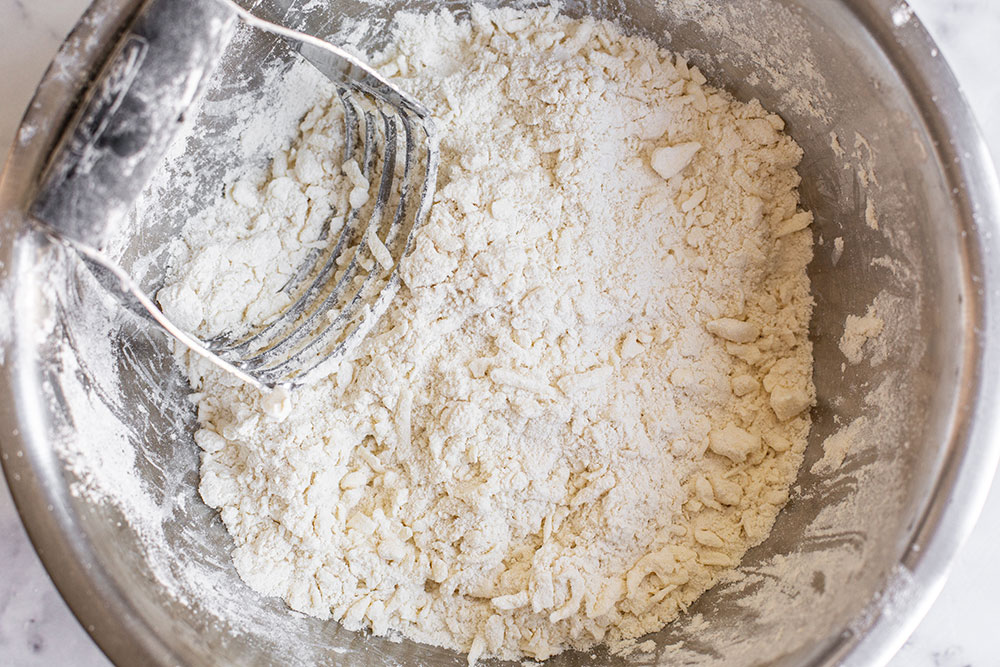
Method 2: Food Processor
Since I live in Phoenix where temperatures often exceed 85°F, I typically use a food processor to make pie dough. It’s quick, easy, and prevents the butter from warming up too much. Cube your sticks of butter with a bench scraper and freeze until firm. Add into the dry ingredients in the bowl of the food processor with the butter and pulse until the butter is the size of peas.
You want the butter to end up the size of little peas. This will help bring the dough together cohesively without overworking it.
Overworking the pie dough develops more gluten, which can make the baked crust tough and dense instead of light and flaky. This can also cause the crust to shrink while it’s baking. Additionally, overworking the dough with your hands can start to melt the butter, preventing that flaky texture from forming.
Creating pea-sized bits of butter will also prevent the butter from pooling into greasy puddles as the pie bakes. I used to use larger chunks of butter and would encounter these grease pools too often, so I’ve scaled back to much smaller pieces.
How Much Water to Use For Pie Dough?
This is one of the trickiest parts of making pie dough. The reason is that many factors affect how much ice water you’ll need to add, such as the climate and humidity of your kitchen and the brand of flour you’re using. That’s why the recipe calls for a range of water. Add half of the total amount to start with. Toss it in to combine either by hand or with a few pulses of the food processor.
Pick up a piece of the mixture and pinch it between your fingers. It should hold its shape. If it crumbles away or seems really floury and dry, then you need to add more water.
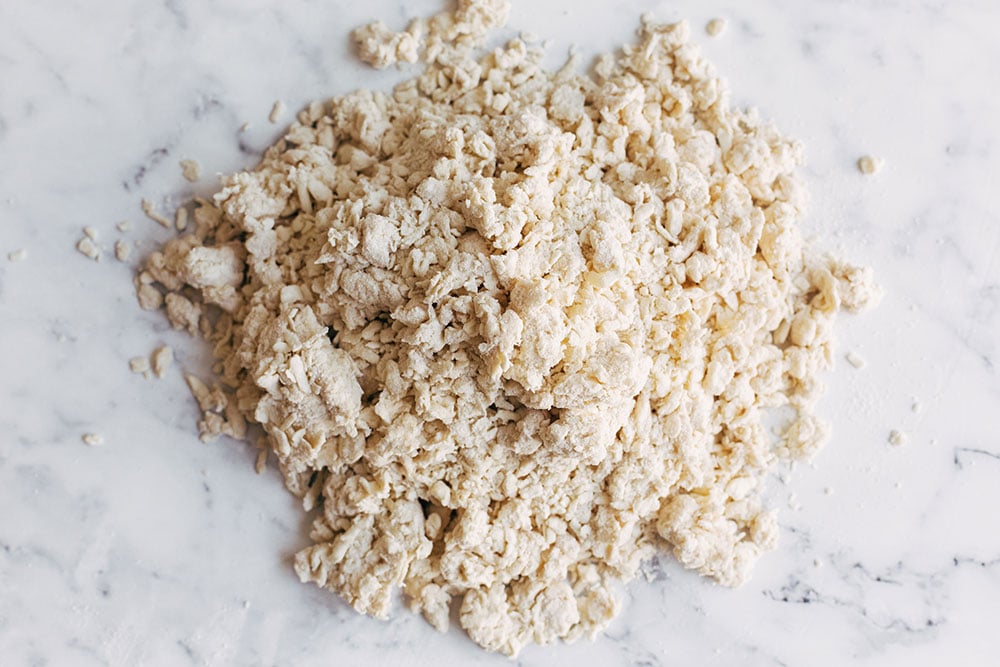
At this point, I like to turn the mixture out onto a work surface and begin pressing it together into one messy lump of dough. Doing so will give you a better indication if you need to add more water.
The dough won’t look like much at first. It’ll be kind of craggly and messy looking, and that’s okay.
Once you have a fairly cohesive mound of dough, flatten it into a disk and fold it onto itself, kneading gently as you work.

Do this a couple of times to ‘laminate’ the dough. Every fold will give you more flaky layers. Just be careful to be gentle and work the dough only until it comes together into a smooth cohesive disk like this:
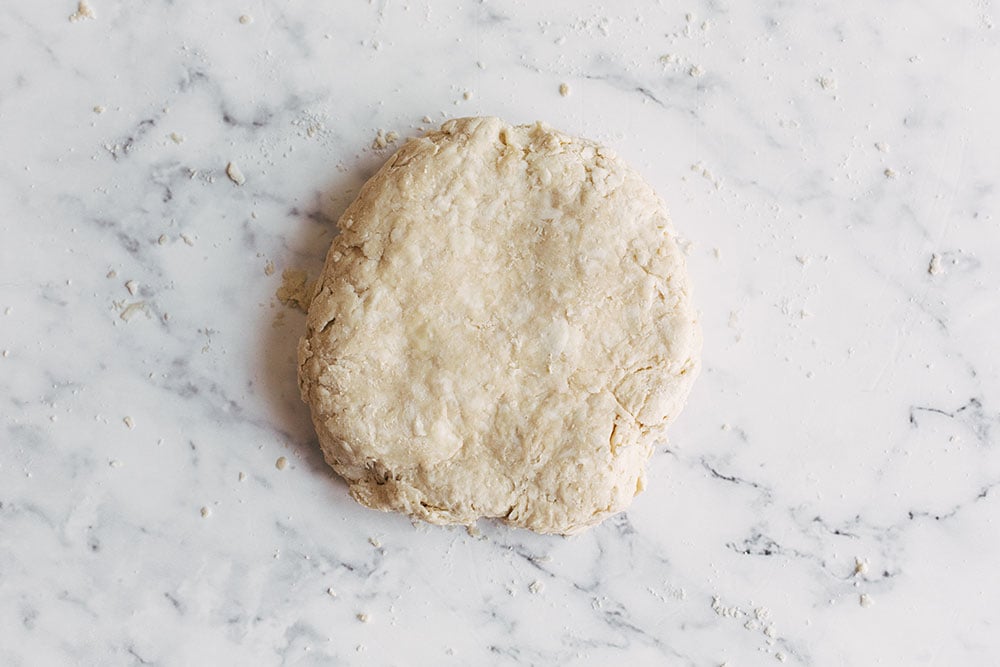
If you were to cut the mass in half, such as for a double-crust pie, you can visibly see the layers of butter thanks to that extra folding step. These layers are going to bake into crispy, tender, flaky goodness:
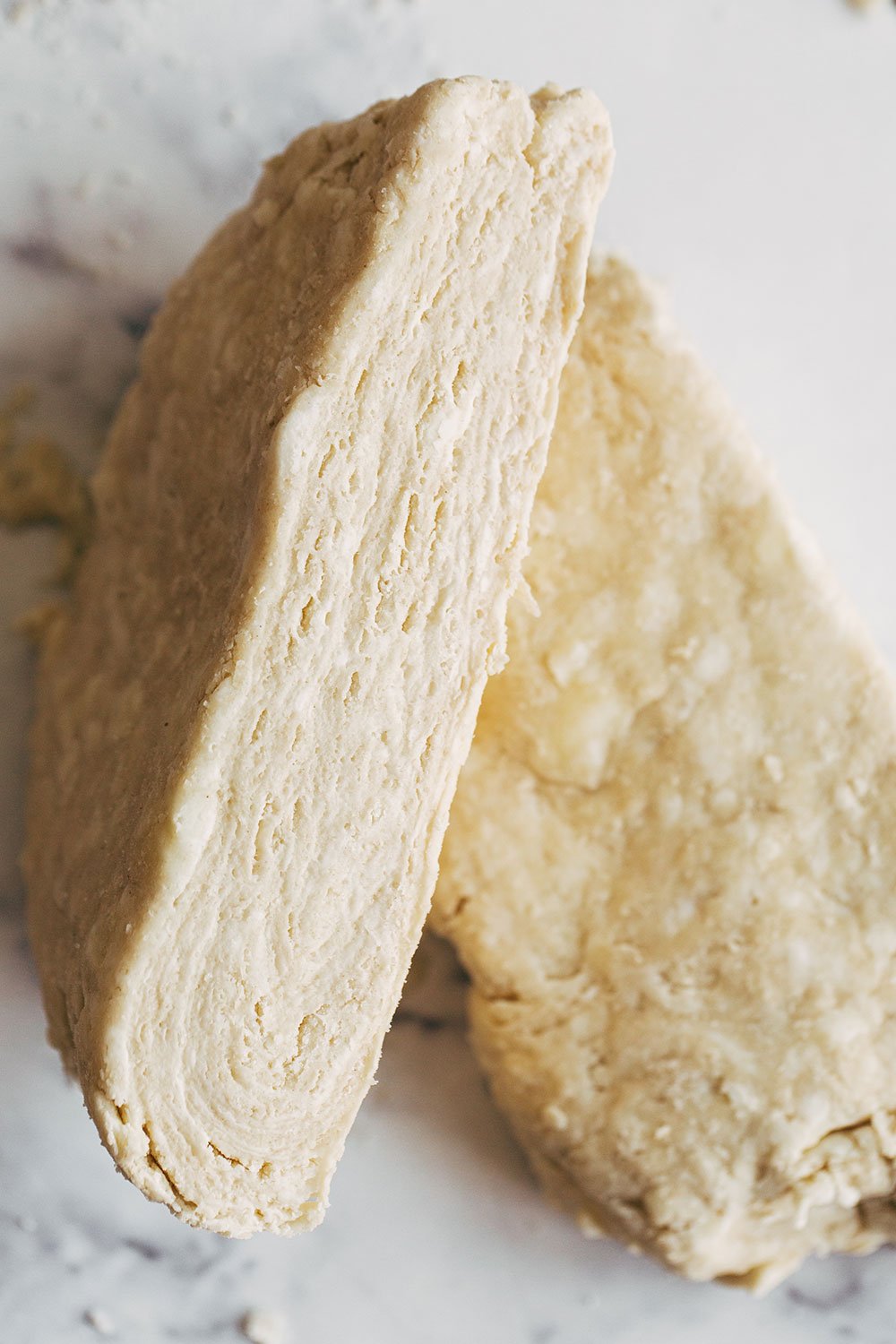
Give the Dough a Rest
If you have problems with your crusts shrinking while baking OR if your crust becomes tough, then it needs more time to rest so the gluten can relax so it doesn’t snap back to its original smaller shape. I’ve included these resting periods in the recipe directions.
After mixing it: wrap it in plastic and refrigerate overnight. You can shorten this to a few hours if you must, but I find overnight really makes a difference in preventing classic pie issues.
After rolling it out: let it rest in the fridge after you’ve rolled it out and placed it in the pie dish and/or after you’ve assembled. Do NOT stretch the dough to fit into the tin, as it will snap back like a rubber band while baking.
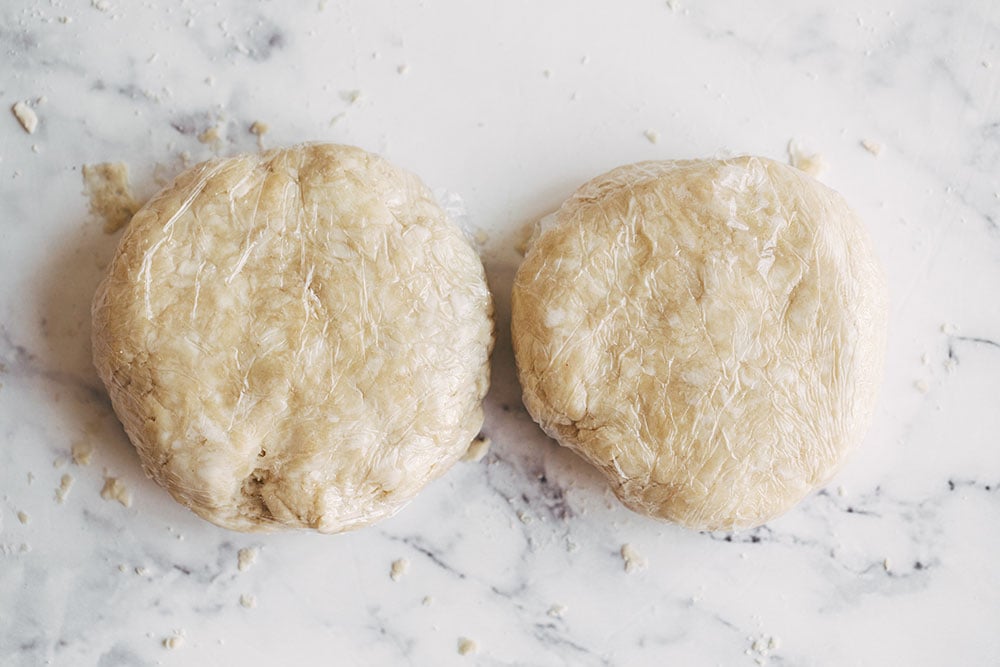
Now let’s move on to the other area of pie crust that I think frustrates a lot of people.
How to Roll Out Pie Dough
I typically roll out my dough on a marble pastry board, but that is totally optional. You can use the trick I mentioned above of icing down your counter before rolling to help keep things nice and cool. Avoid overworking the dough as you roll it out. Keep the dough moving on a lightly floured surface so you don’t roll over the same areas repeatedly, making it tough.
You’ll want about a 12-inch diameter for a 9-inch pie pan. Some pans are deeper than others, so factor that into your rolling. Whatever you do, make sure the thickness is about 1/8-inch for your pie crusts. Thinner will result in rips and tears. Thicker and it won’t cook through and get flaky.
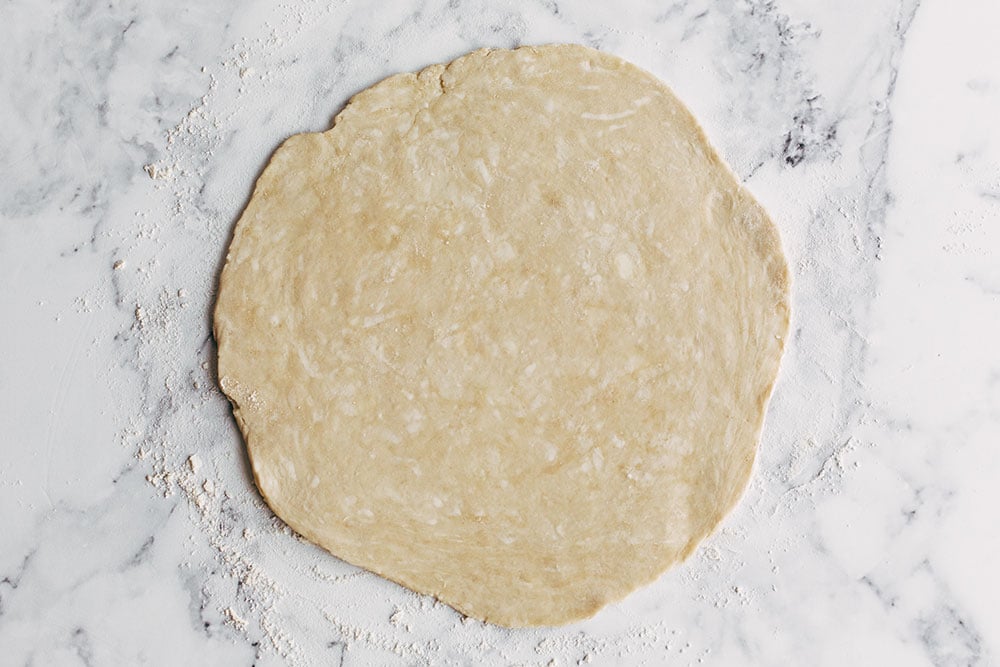
Flour your work surface, the dough itself, and your rolling pin throughout the process as needed. There are two inexpensive tools that I find are both a MUST when it comes to rolling out pie dough: a flour shaker and a bench scraper.
The flour shaker allows you to easily add flour wherever sticking might be happening. The bench scraper allows you to easily keep the dough moving as you roll it out, which is essential. I keep the dough moving in quarter-turns to prevent sticking and to keep it an even thickness.
Alternatively, you can roll the pie dough out between two sheets of parchment paper or plastic wrap. I find that most non-commercial paper and plastic wrap isn’t big enough to accommodate a 12- to 14-inch diameter circle, so I don’t often use this method.
If at any point the butter begins to get melty and sticky, return the dough to the fridge immediately.
Use your fingers to flute the edges of the pan if you wish. I find that I need to make a more dramatic flute than I might think since the design will loosen during baking. Whatever you do, don’t make the flute too thick and heavy, otherwise it’ll slump down the sides.
More Dough Than Other Recipes?
You might notice in the recipe below that I call for more ingredients than other recipes. This is because I think it’s easier to work with dough when you have a little more than you may need. It comes together more cohesively and if you get any rips, tears, or make any mistakes with a design, you have extra.
This especially comes in handy if you have a deeper pie dish or if you want to get fancy with any designs.
Pie Crust: Butter vs. Shortening?
I’ve done an extensive amount of testing on pie crust. Let’s just say my kitchen has seen a LOT of butter. I made the messes and did the testing so you don’t have to. Here’s what I learned.
When it comes to pie dough, I’ve heard a lot of confusing and conflicting opinions about which is the better fat. If you’re curious, you can learn more about the general differences between butter and shortening here. But I actually tested the two fats in pie crust side-by-side to compare. I still need to do testing with lard, so stay tuned for that!
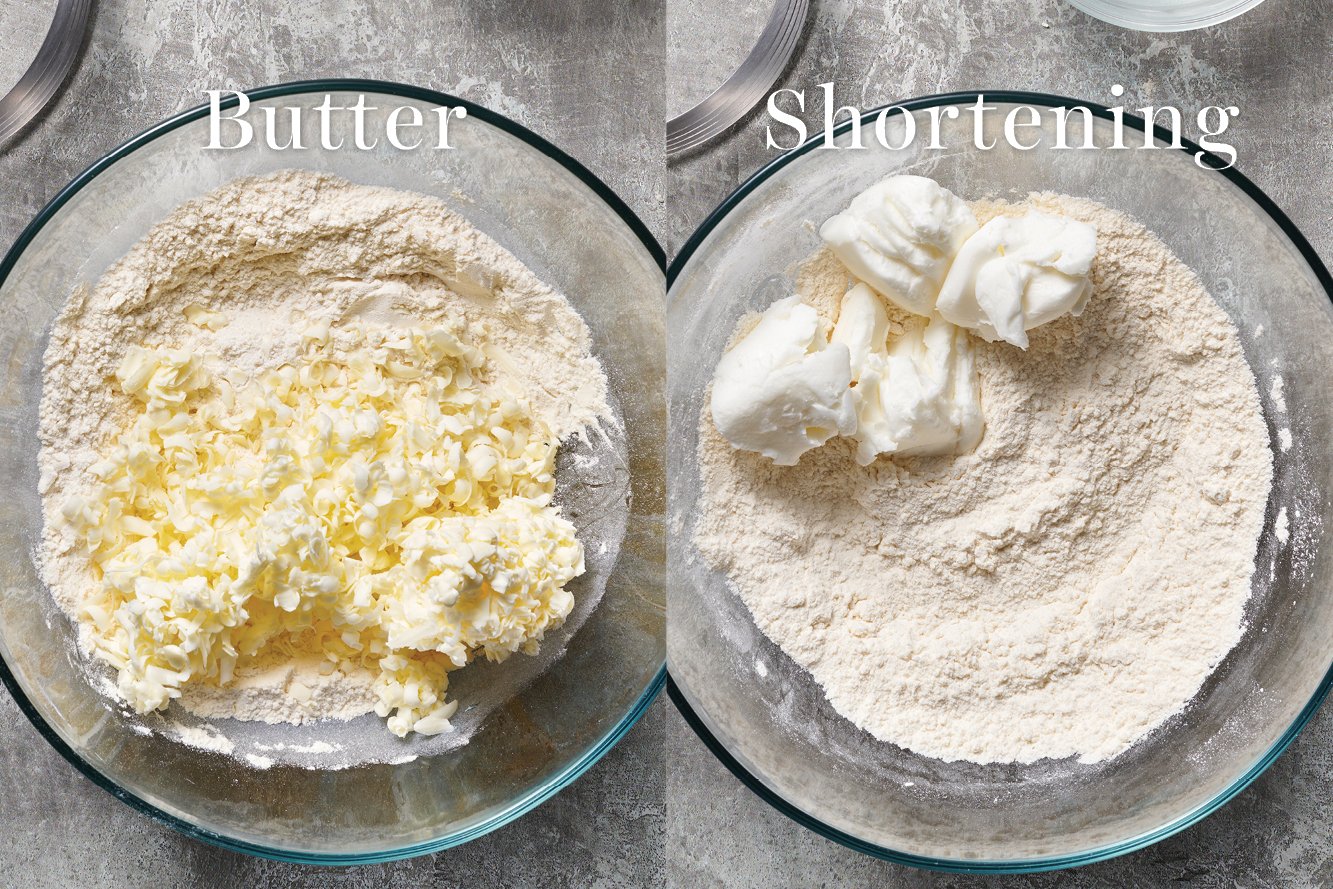
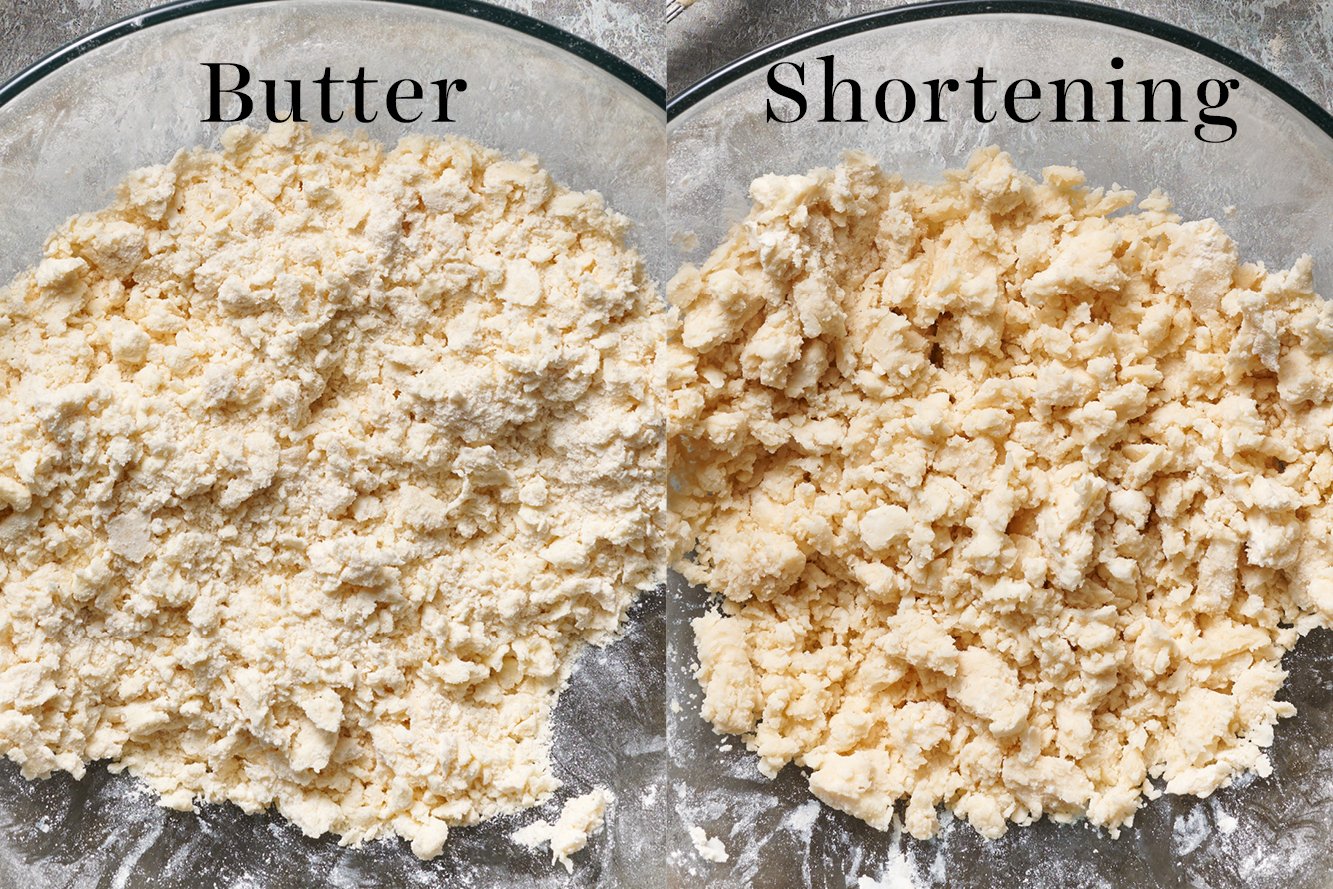


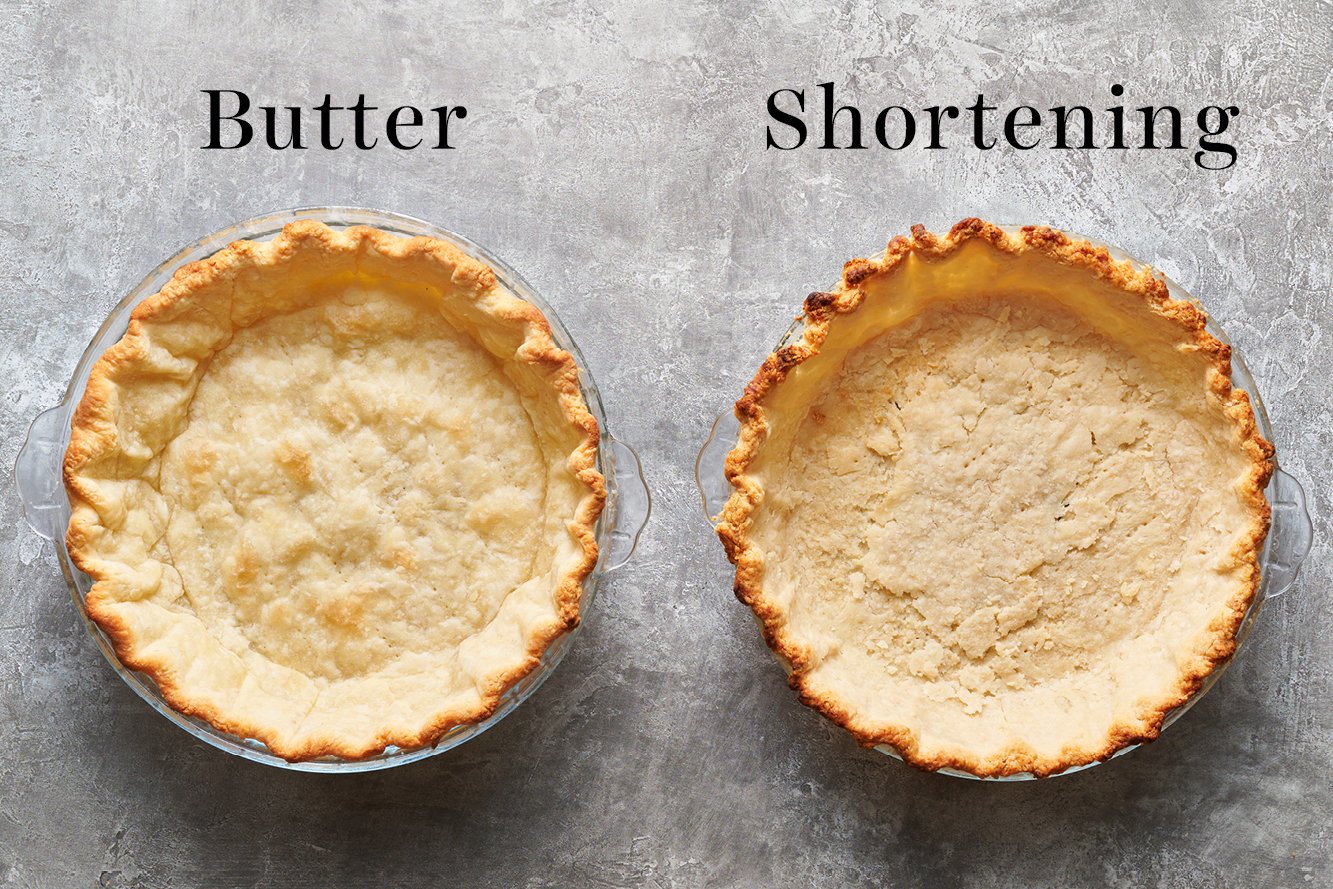
Shortening
All-shortening dough can be easier to work with in one sense because unlike butter, shortening requires less chilling time. Shortening has a higher melting temperature than butter. However, this also means that unlike the very hard chunks of cold butter that remain in the control dough, shortening is soft enough that it is easily overworked, resulting in a crumbly crust instead of a flaky crust. In our blind-baked shortening crust, the parchment paper holding the pie weights actually stuck to the crust, pulling some of it off with it.
As you can see in the photograph, the all-shortening dough ended up being flat, tender, and fairly crumbly. The texture was actually reminiscent of shortbread, and it was completely lacking in flavor. In fact, the flavor reminded me of store-bought dough.

Butter
In this all-butter dough, there were plenty of visible chunks of butter studded throughout. Once it came together and was chilled, it was a bit of a challenge to maintain that perfect temperature where it’s warm enough to shape but cold enough that the butter doesn’t melt. Especially for me living in the desert. The extra effort paid off immensely, though. This pie crust was ridiculously light, flaky, and loaded with rich buttery flavor. You could immediately tell this was homemade, in the best way. This is why I almost always prefer a 100% butter pie crust.
If you like the benefits of shortening, then I’d recommend a 50-50 ratio of butter and shortening to get the best of both worlds.
Other Pie Crust “Tricks” Put to the Test
Vodka in Pie Crust?
A few reputable sources have claimed that by substituting a portion of the water with vodka in a pie crust recipe, you prohibit gluten development and therefore ensure a tender, flaky crust. I tested this against my standard pie crust recipe and found the differences to be slight. I don’t think it’s worth the extra effort if you don’t have chilled vodka on hand.
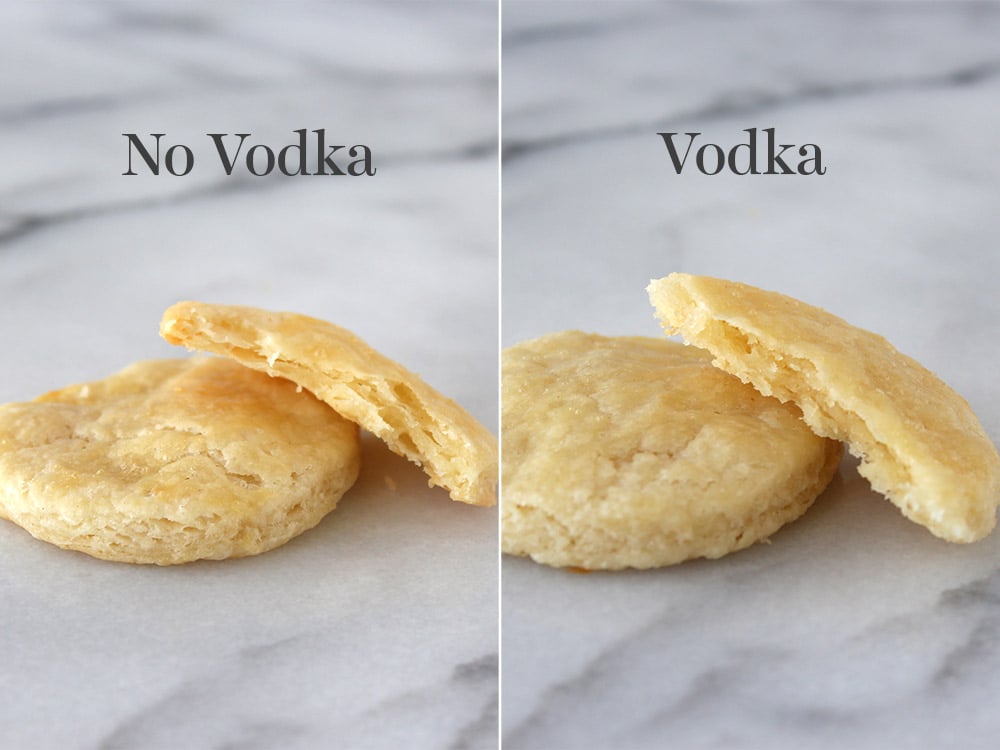
Optional SECRET Ingredient!!
As you can see, I’ve done a lot of side-by-side testing of pie crust variations. Most of the time the classic recipe has won out, with a single exception: SOUR CREAM!
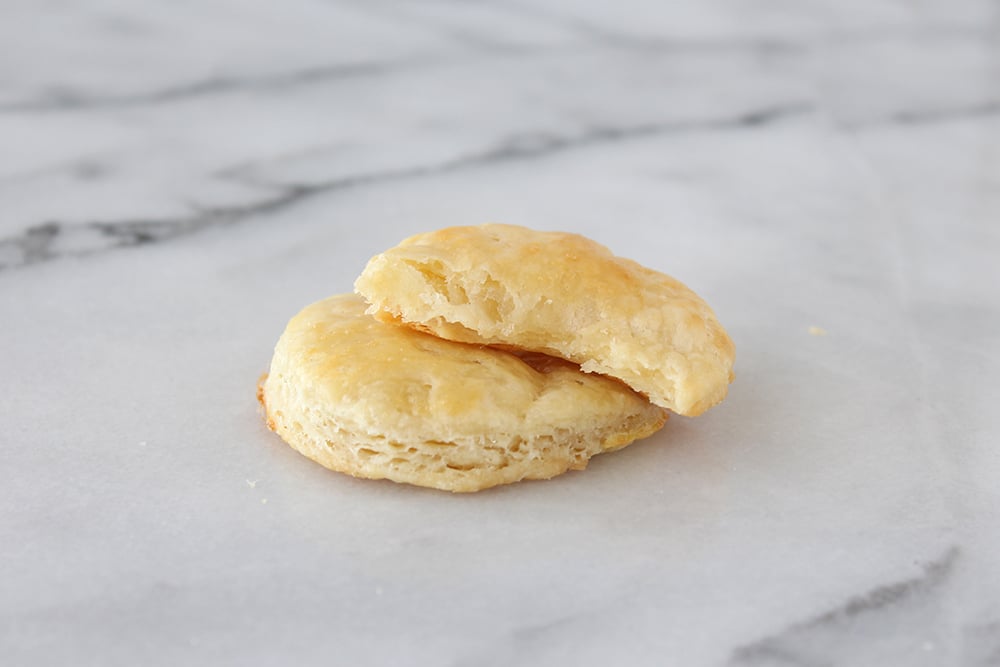 Sour cream acts as a tenderizer in baked goods, and I was curious to see if it would significantly affect the texture of pie crust.
Sour cream acts as a tenderizer in baked goods, and I was curious to see if it would significantly affect the texture of pie crust.
- I added 2 tablespoons of sour cream to my standard single recipe along with the butter.
- This dough was very soft and slightly sticky, but easy enough to work with.
- The texture was ultra-light, puffy, and flaky, almost like puff pastry.
- This pie crust puffed up to a surprising height.
- If you have sour cream handy, I definitely suggest giving it a shot.
How to Add Sour Cream
Add in 2 tablespoons to the single recipe below, and reduce the water by about 2 tablespoons, or as needed.
Can you Make Pie Dough Ahead of Time?
Yes! Here are your options:
1. Chilling the dough disk: Pastry dough can be shaped into a disc and refrigerated for up to 3 days, as long as it’s well wrapped in plastic.
2. Chilling the unbaked pie shells: Refrigerate for up to 3 days. Simply roll out your dough, lay it into your pie tin, crimp the edges, and cover loosely with plastic wrap. When ready, simply remove from the fridge, fill, and bake. This works perfectly for single-crust pies like pumpkin or sweet potato.
3. Freezing dough: Pastry dough can also be shaped into a disc and frozen for up to 2 months, well wrapped in plastic, and placed in a freezer bag or airtight container. Defrost in the fridge overnight before rolling out.
4. Freezing pie shells: Unbaked pie shells can also be covered and frozen for up to 2 months. No thawing necessary.
How to Bake Pie Dough
I’ve included instructions on how to blind-bake the crust for recipes that require an already-baked crust. Otherwise, just follow the directions in the pie recipe you’re following for baking the crust – or, check out my full article on How to Blind Bake Pie Crust here!
The Best Pie Pan for the Best Pie Crust
The material of your pie pan can make a big difference in how your pie bakes. I recently used this Best Ever Pie Crust recipe to experiment with different pie pans, to determine which pie pan is best. Check out my Best Pie Pan article here to see my side-by-side experiments using glass, ceramic, metal, and disposable pie pans, and learn which pie pans I recommend.
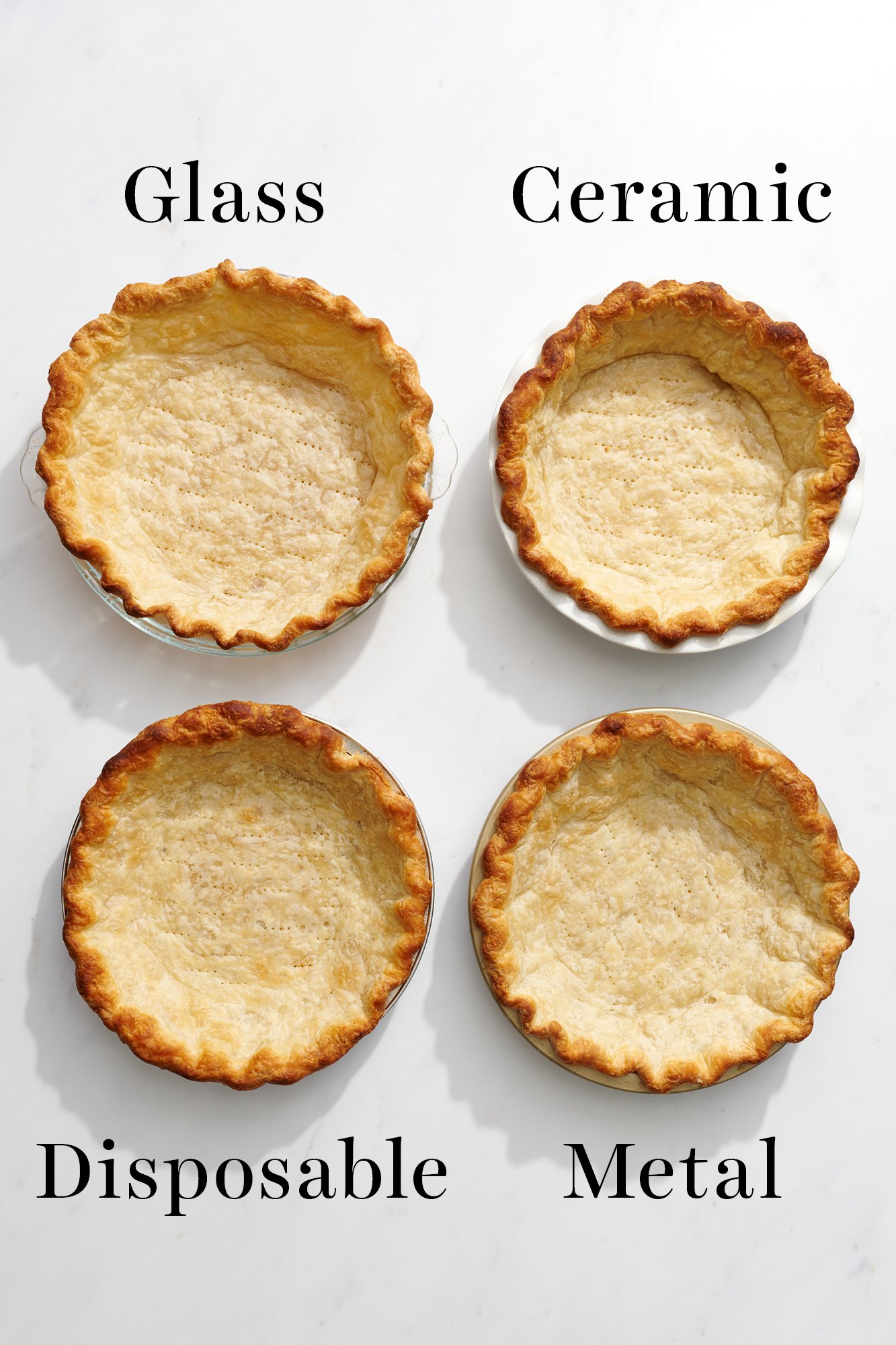
Expert Tip!
Place your pie pan on a rimmed baking sheet before putting in the oven. This helps you to remove the pie tin without damaging the crust with your oven mitts. Better yet? Place the sheet on a BAKING STONE to ensure a golden crispy bottom crust and avoid any sogginess.
Take a look at these pies using this recipe, all made by HTH community members – many of whom had previously struggled to master pie dough! Follow the tips in this article to bake pies that look like these:

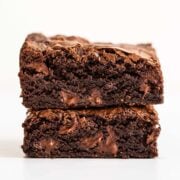





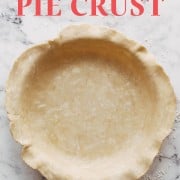
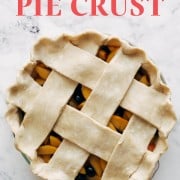

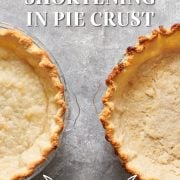

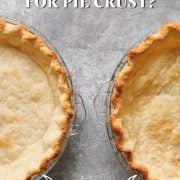

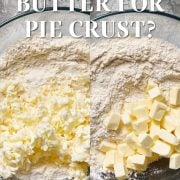
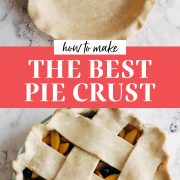

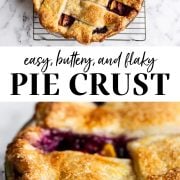
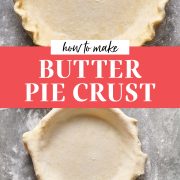
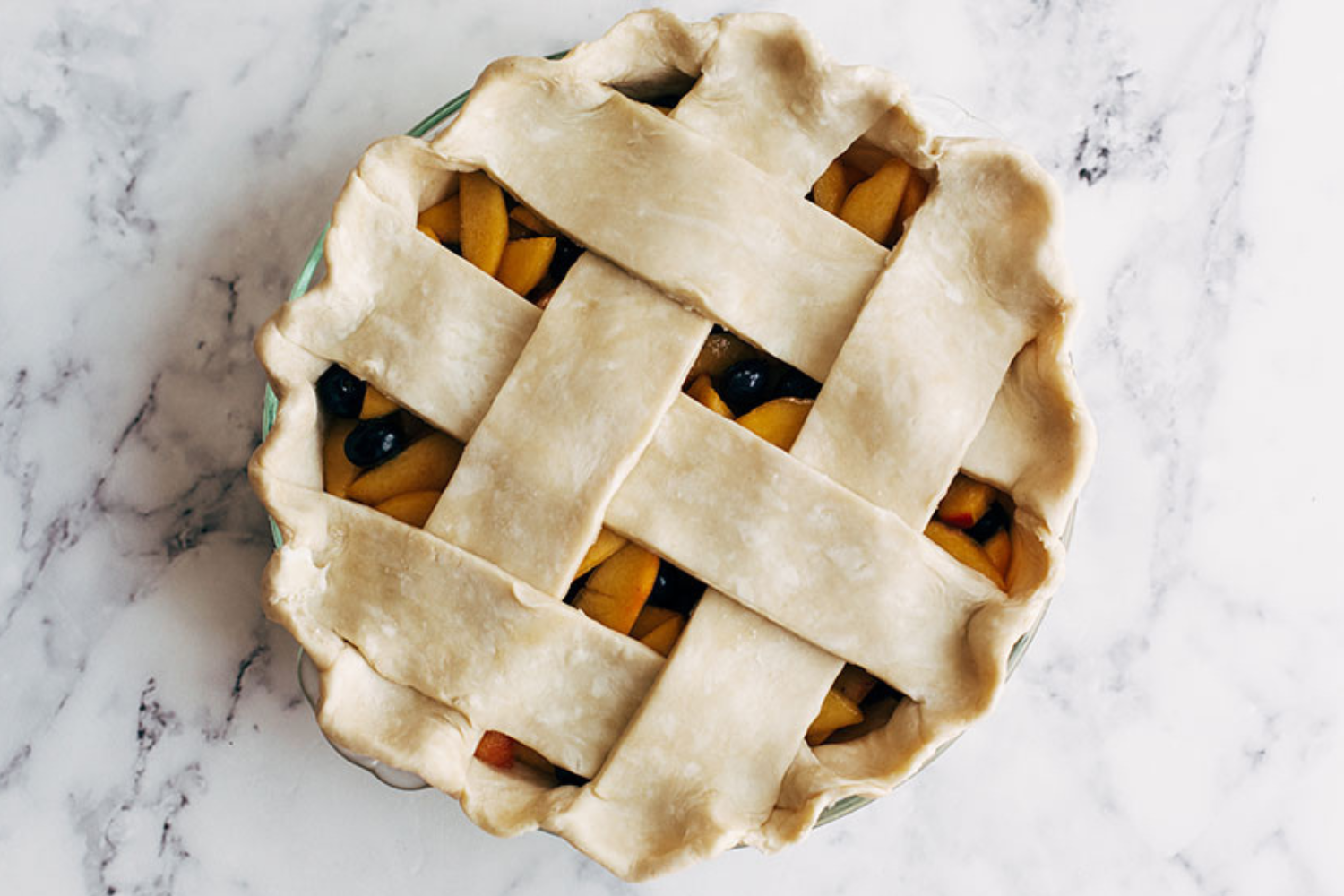






















 Sour cream acts as a tenderizer in baked goods, and I was curious to see if it would significantly affect the texture of pie crust.
Sour cream acts as a tenderizer in baked goods, and I was curious to see if it would significantly affect the texture of pie crust.
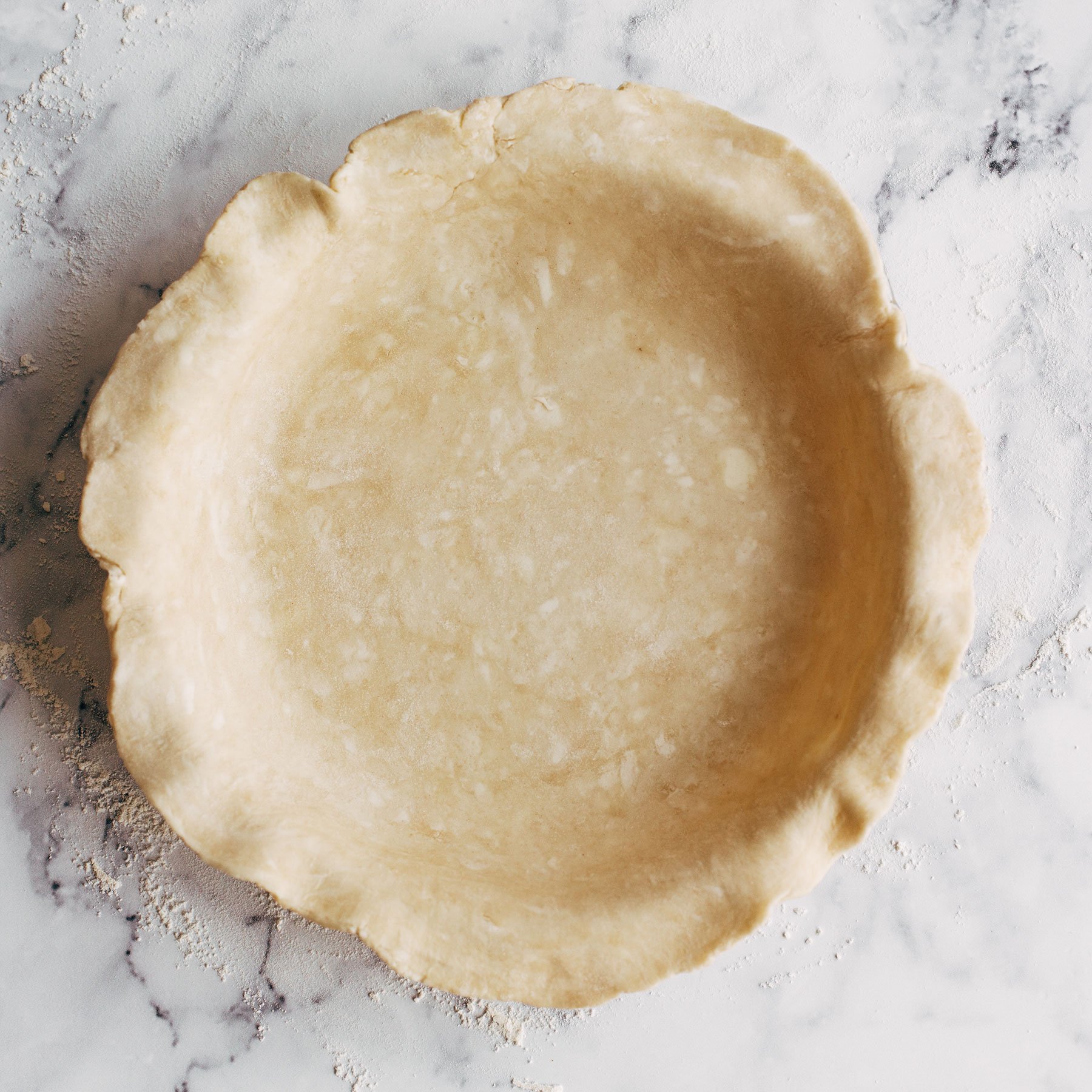


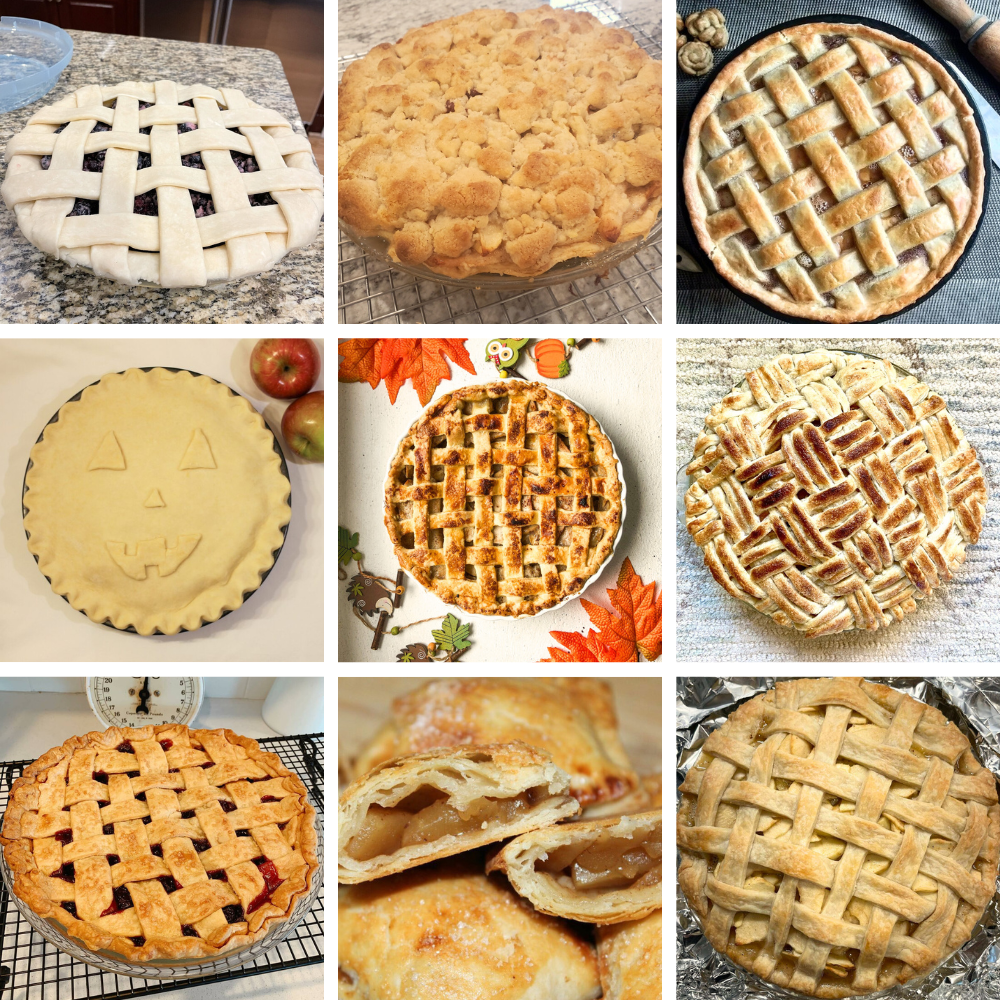



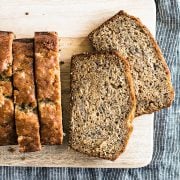
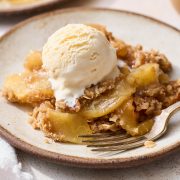
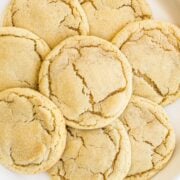
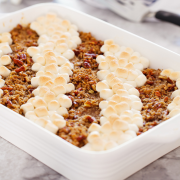

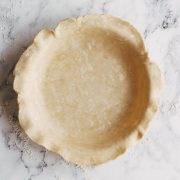
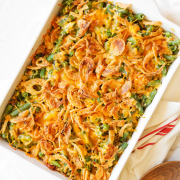
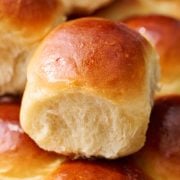
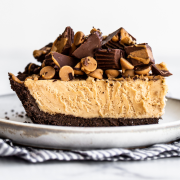

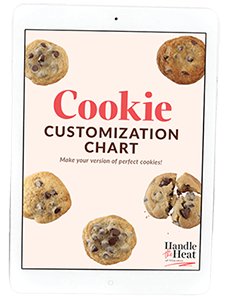
Yummy!!! Easy to make with the directions followed, I even added the sour cream!
Yay!! Love that you tried with the sour cream as well 🙂 Thanks for commenting!
For a long time, I have tried pie crust recipes and would end up so frustrated! Then along came Tessa’s Best Ever Pie Crust recipe with all her tips, techniques, and easy to follow instructions. I am so happy that is made with all butter. I have now made three pies with this recipe and they look and taste almost perfect come out perfect. Thank you Tessa and HTH for yet another Best Ever Recipe.
So glad to hear this, Sarah! Thanks so much for letting us know!
I followed the directions exactly as written and am shocked. This is the first pie crust I have ever liked. Usually I have scraped my pie fillings off the crust and just eaten the insides and thrown away the crust, but this crust is actually good! It was cooked all the way through, it was flaky, it was great.
Amazing! So happy to hear how much you love this pie crust, Misha!
Confession time: I often skip eating the crust of pies because I’ve found they often don’t taste all that great (usually store bought), at least not nearly as good as the filling. Homemade pie crusts always taste so much better, but every time I’ve attempted to make homemade pie crust, it ends up shrinking and my crimping of the edges doesn’t look all that great either. Until now! I made this recipe and it is delicious and the directions are easy to follow. My pies turned out great! I made a shoo fly pie and the chocolate chess pie here on this site. So, so good! Cannot wait until Thanksgiving so I can put all my new pie crust baking skills to work!! Thank you, Tessa, for another fantastic recipe!
Yay!! So happy to hear that, Cindy!
This recipe is so easy to make. The first time I ever tried to make a pie crust, it went Horribly and I vowed I would only buy premade again. I decided to give Tessa’s recipe a shot and it was so easy and delicious, I now have the confidence to continue to make my own pie crust from scratch!
Amazing to hear this, Kiersten! So happy you gave this recipe a try, yay!!
Took a while to chill between steps, but it was SO worth it for the flakiest pie crust I’ve ever made! Despite the chilling it was a really easy recipe to make, and I used my food processor to make the dough. Such a delicious butter flavor!
Wonderful! Happy you gave this recipe a try, Ellen! 🙂
So flaky and buttery! The perfect crust. And SO. MANY. AMAZING. TIPS! Read through the whole thing if you want to be a crust master!
Yay!! LOVE to hear that, Kelly! Thanks for sharing your rave review!
This crust is so flakey and delicious! I love it!
I usually need non-dairy desserts, as I keep Kosher. Could I uses the same proportions if use Earth Balance sticks? I know that the taste will not be close to real butter! Thank you.
PS I respect that you hate substitutions, but this is a bit of a different request.
Hi there! I’d love to help you, but we honestly haven’t tried that! Please let us know how it goes if you give it a try 🙂
So glad to see a pie crust recipe using butter instead of shortening! I will definitely be trying this the next time I make a pie. I’ll come back and rate it once I’ve made it.
Thanks again!
Excited for you to try this recipe, Judy!
I used 1 c all purpose flour and then white wheat to get to the WEIGHT specified.
I also added sage and thyme (not enough), since I was making top crust for two pot pies.
It turned out very flakey and tasty, though it was probably thicker than intended. (Next time I’ll try freezing the extra for use another day.)
The 2nd pie is going into the freezer – we’ll see how it works.
I didn’t have time for all the chilling required, so instead of refrigerating for 6 hrs, I put it in the freezer while making the filling. That worked fine.
Glad to hear you enjoyed this recipe for pot pie, Carol! 🙂
Awesome pie crust recipe. Love all your tips and tricks
Made homemade Mater pie with this crust and it was phenomenal!!
I saw on Julia’s PBS show years and years ago; this woman took her rolling pin and whacked the dough after it came out of the refrigerator. Julia asked her why – Flaker crust. So I’ve always whacked first the rolled.
haha, interesting! Love watching Julia’s show too. Thanks for the comment, Cathy!
(Most of the comments/questions about the pie dough are from 2017. I hope you’re still answering new ones.)
So in your YouTube video on rolling out pie dough, you make it a point to say that you find pea sized chunks of butter to be too small and recommend larger chunks for a flakier crust. But in this recipe, you specifically say “pea sized”, or even recommend grating your butter on a box grater. So which is it?
Hi Alan! The recipe that the YouTube video follows is from an old recipe from 2017. We actually noted in this post that the previous pie recipe was completely overhauled as Tessa took feedback that she’s received over the years from readers to improve the recipe. Please follow the recipe on our site 🙂
Absolutely perfect each time!
I love how detailed you get- thank you! I like to know the whys and understand everything but am not about to embark on these experiments myself! FYI my new favorite ever crust is using half lard, half butter- can’t wait to get your thoughts on lard
I’m so glad to hear this helps, I absolutely love experimenting in the kitchen and sharing my results! Still need to test lard 🙂
Hi, thanks for the detailed testing and explanations. Wondering if you’ve ever tried cake and pastry flour vs. All purpose?
I haven’t, I’ve always preferred all purpose flour in pie crust because of its protein content. The dough is also easier to roll out and move around but is still super flaky.
I’m so confused. The instructions clearly stated to cut the butter into “small sized peas” but your response in the comment section says “small sized peas” is too small and the butter will melt while being mixed. Please clarify!
Also, instructions say to refrigerate overnight after mixing, then refrigerate overnight after rolled dough is placed in pie pan. 2 overnights to bake a pie? Seriously … I have never been so confused by a recipe, but I really want to try this all butter pie crust.
Hi Sally! This recipe was revised in 2020, the comment you were referring to was posted back in 2017. Definitely follow the written instructions and the tips I share in the pink box for the pea-sized butter. The overnight times are optional, I share how many hours you can do instead! Hope you give this recipe a try!
Thank you for taking the time to respond!
Really appreciate it so much.
Happy to help!
I have an issue with the all butter pie crust. I use good quality ingredients but when I try to blind bake a crust it just melts and starts to droop down the sides leaving melted butter in the crust. I freeze the crust prior to baking and line the crust with pie weights. I have a very expensive thermometer in the oven so I know the temperature is correct. What is the problem and how might I solve it? Also I have not been able to receive your Pie Crust Troubleshooting Guide.
Never been able to roll out a pie crust until this recipe. Great find
My pie crust shrank and went down in my pecan pie along with my decorative crust leavesI even had it hanging a bit over when I read about shrinkage. But wow really shrank I’m cooking pumpkin as I write and it is doing same thing. I’ve always used butter for my crust but not the amount of water and sour cream thought it would work because I needed to make the crust and refrigerate.
I am a good cook with decades of experience, but I am a HORRIBLE pie crust maker. This is the first pie crust I’ve ever made that actually lived up to the promise of being the best pie crust ever! It was easy to roll out, completely gorgeous in the pie plate, it was flaky, buttery and super flavorful. I actually ended up using all 6 tablespoons of water because I tend to make crappy pie dough that’s crumbly and hard to hold together, but not this one. And that folding technique is something I use to make biscuits but I never thought to apply that method to a pie crust – THOSE LAYERS ARE ON POINT! I just couldn’t be happier with the resulting pecan pie it became! Thank you for so many great tips for a truly perfect recipe!
This makes me ridiculously happy! So, so thrilled you loved this pie crust recipe, Erin!
I made the recipe and replaced 2T. of water with 2 T. vodka; looking forward to the end result on Thanksgiving Day! And, I loved the technique of using a box cheese grater for the butter/shortening when hand mixing. There is always something new to learn at Handle the Heat!
I would also love to know Tessa’s thoughts on storing the dough disk(s) — how many days before baking can the dough be stored in the coldest part of the fridge, or should it be frozen if longer than, say 24 hours? And, best way to thaw frozen dough before rolling out?
Pastry dough can be shaped into a disc and refrigerated for up to 3 days, as long as it’s well wrapped in plastic! I give lots more details on how to make recipes ahead of time in my free Make Ahead Baking Guide!
I have never been a huge pie person before, generally sticking to cakes and cookies. However, after apple picking this year, I knew I could trust Tessa with an awesome pie crust recipe and she did not fail on that. If it was possible to fall in love with a pie crust, I definitely did with this recipe. It was perfect! My husband is already thinking of other ways to use this pie crust, lol. Thank you Tessa for this amazing recipe!! I cannot wait to make it again 🙂
This makes me so incredibly happy, Jennifer! Thanks so much for sharing.
Made this crust for your peach blueberry pie and LOVED IT! The resting really changes the game As I look toward Thanksgiving, I’m hoping to start prepping/making ahead what I can ASAP. When would be the best spot to freeze/store the dough? How long will unrolled dough keep in the fridge or freezer?
I used this crust when making your peach blueberry pie and it was amazing. This weekend I used it (minus the sugar) to make individual chicken pot pies. So good!
Tessa, try the paste method for crust. No waiting no resting no temperature worries and it NEVER FAILS.
Tessa, I have a problem with my crusts erupting upward off the bottom of the pie plate while cooking. Just baked 3 pumpkin pies and blind baked the crust with pie weights beforehand but one of them still ballooned up causing a small geyser like situation just off center of the pie. It settles down once out of the oven but that area of crust remains less cooked than the rest of the bottom and also causes a divot like spot in the filling. I use glass pie plates. SOS!!
Best recipe.
My husband rated this the best crust he has ever eaten!
4th crust in a row for me and all came out perfectly! All I had to do was follow Tessa’s instuctions carefully and it’s all so easy. Thank you so much
I love this recipe but has it been updated it in the past few weeks? I could’ve sworn before it said to cut the butter bigger than pea size with pictures, among other differences
I’ve been baking for 20 years. I’m also a chemist. Pie crust has been my NEMESIS. I swore it off on my last attempt 4 years ago, but for some reason I wanted to try this. And it WORKED!!! Holy crap!! It was so easy to work with and actually tasted good. FINALLY!
I doubled this recipe today for a cobbler. It’s the first time I’ve made a crust without shortening. And, it has been a very long time since I made my own pie crust. Following your recipe and tips on rolling out the dough, it turned out great! Thank you for your wonderful instructions and video.
I am really excited to try this recipe. I have used others, including Ina’s “Perfect Pie Crust” — but I found it was anything but perfect.
Question: I am planning to make a double crust apple pie and I’d love to use my Emile Henry pie pan. Should I preface the bottom shell at all? Or should I brush the inside bottom to ensure it doesn’t get soggy?
Do you have any suggestions for a great apple pie?
Love it. Used the sour cream. Perfect. 🙂
recipe says preheat oven to 400 and bake 20 minutes
comments say bake at 350 for 45 minutes
Have you updated the recipe to the higher temp and lower time?
Would this crust recipe work for handheld pot pies such as pockets or pasties?
I used this recipe a few months ago, followed it EXACTLY, and it was the best pie crust I’ve ever made!! Thank you Tessa for taking the time to experiment and create amazing recipes to share with us all
P.S.- The Auther states… “Place your pie pan on a rimmed baking sheet before putting in the oven. This helps you to remove the pie tin without damaging the crust with your oven mitts.” However, I would certainly not recommend baking your pie on a rimmed cookie sheet, unless you have a heavy gauge pan… as mine bent in the oven due to the heat & threw my wet pie all over inside… ugh!
WARNING…!!! Don’t Follow Her Instructions…!!!
Author of this recipe said… ” I added 2 tablespoons of sour cream to my standard recipe along with the butter, keeping everything else the same.”
Then, Later she said… “Add in 2 tablespoons (of sour cream) to the recipe below, and reduce the water by about 2 tablespoons or as needed.”
Well, it’s certainly too late for me to reduce the water by two (2) tablespoons. Hopefully, you’ll learn from my mistake, when following her poorly written instructions! Unless she deletes my corrective review… ugh!
Hoping someone can help… I try following the recipe, but I get either good sized butter bits with REALLY dry flour (even with all the water), or good consistency but no butter bits. Help!
Like the other comments, WOW to the size of the butter chunks. Can’t wait to try this. Also, (on another blog) the blogger was using a refrigerated, roll out pie crust and said to use powdered sugar instead of flour to keep from risking a tough dough. That was an eye opener, and I can’t wait to try that since I often use the refrigerator dough. I always brush the top crust or the sides with an egg wash and sprinkle with a tablespoon or so of sugar before baking. It comes out crispy, if not flakey.
Tessa, Try the Flour Paste Pie Dough recipe from Joy of Cooking. My copy is from 1975. Major difference between this recipe and most recipes is you separate one third of your dry ingredients into a separate bowl and add a quarter cup of water or enough to make a thick paste. Incorporate the shortening into the two thirds dry ingredients. Then combine the two until well incorporated and the dough forms a ball. You do not have to let this dough rest, you just roll it out. I once won a pie baking contest and knew I was the winner when I heard the judge say “the crust.” This is perfect every time.
Hi, Tessa! This is my favorite site for recipes. They are always the most delicious!!! I made four of these crusts for Thanksgiving pies. I just had two issues with them and was wondering if you had any advice.
1. I used glass pie pans, and the crust seemed to stick to the pans. Is there any trick to making the slice come out easier? I’ve read every instruction and comment and didn’t see anything about greasing the pans.
2. I made a chocolate meringue pie (I would love if you created a recipe for this!!!!), but the bottom came out super soggy. I completely blind-baked the crust before adding the filling. Would the egg or flour help here when blind-baked or does that only apply to the unbaked pies?
Thanks, Tessa. You’re the best.
Is there any way you could post some photos of the butter chunks you cut beforehand? I can’t figure out what size to cut them. Do you just slice them the size of a butter pat? Do you cut the stick vertically down the middle and then slice it horizontally (i’m confusing even myself here). I’ve only ever made butter pie crust but I always have trouble with it melting and being “overworked” (it always comes out flavorful but flat).
I cube the butter: slice it horizontally once, flip the stick, and slice it horizontally again so there’s 4 logs. Then I make cuts to create square pieces. Does that help?
When you are “cutting” in the butter, how do you keeps the chunks so big as in the photo and still have it cut/mixed in? I use the Vodka crust, are you saying it is close to this all, large chunck, butter recipe shown here?
Hi Tessa!
I’m soooo glad you did a very informative article on making pie crust! I love to bake, but I usually stay away from scratch pie crust recipes because I always seem to have issues with overworking and shrinkage as another reader stated. My kitchen is probably too warm to make pie dough and I think that may be at least some of the reason why I at least have the shrinkage problem.
I have a question that I really hope you can answer – Is there a reason why you don’t (or shouldn’t) use sliced frozen butter as opposed to cold butter? Will it not work into the flour as well?
I look forward to your answer. Thanks and Happy Thanksgiving!
Hi, Bella! I find using frozen butter can make the dough too brittle, leading to cracks and tears when you work with it. Hope that helps!
I’m not able to print the recipe. would you know, it’s not mandatory, but when my granddaughter is judge for 4-H they prefer lard, would we use the dame amount of lard as it calls for butter?
Hi Tessa!
I really like using cast iron pans for Pies. Would the pie crust turn out ok using your pie crust recipe? Would the temp and baking time be different as well?
Pre baked for 45 mins @350 seems like a lot. What temp do you use for pre baked. Is there a particular type of butter you use, some have more water then others? Chunks of butter do look pretty massive, was that more for photo? Sour cream, use this method only if doing a top crust, such as for apple pie? Thank you!
You answered your own question 😉 Yes, 350°F. This is lower than many other recipes, so it shouldn’t be a problem. Start checking at 30 min if you’re concerned or if your oven runs hot. Any quality brand of American-style butter should be fine. Nope, those are how big the chunks should be so they don’t melt before they enter the oven. Sour cream method is up to you!
I’m fresh out of unsalted butter( it’s a tragedy) so I’m going to delete the salt and try salted butter. I’ll let you know how it works. I’m thinking the unsalted butter doesn’t melt as quick, we shall see.
I am definitely guilty of overworking dough and dealing with shrinkage issues…I will be more aware from now on. Two questions:
-How do you avoid overworking dough when you need to reuse the rolled scraps left from the bottom crust?
-The pieces of butter throughout dough in your photos are so large…do you ever have pools of melted butter in the baked crust?
Make two batches of dough instead of using re-rolled scraps 😉 The only time I had a small pool of butter using this recipe was when there was a tear in the crust going into the oven. I wanted to see what would happen! Still worked perfectly fine though.
You infer that OXO glass pie plates are the best, but you’re using ceramic. Sponsor?
I’m giving the reader three different options… Also this post isn’t sponsored.
Would this pie crust also work for tart shells? 🙂
I haven’t tried! Though tart crust usually has an egg and more sugar, so it’s a little different.
Did I read correctly? You bake an pre baked pue shell with the pie weights in it for 45 minutes?
Yes! But the pie is baked at a lower temperature than other recipes might call for. That time should get you a totally baked golden shell ready to use in a recipe that needs one 🙂
My problem with pie crusts is that my crusts don’t seem to hold together very well with just 4 TBSP’s of water. I often wonder if the recipe writer has a bigger TBSP. I do notice that your butter pieces are bigger than what I thought they were supposed to be. I thought “pea sized” was what was required. I’m going to try your pie crust recipe for sure. Thanks for all the tips.
Hi Stephanie! You’ll notice this recipe actually has less flour than most other recipes so you don’t end up having to add a ton more water 🙂 And pea sized is way too small in my experience. At that size, the butter will start to melt super quickly as you’re working with the dough.
How about pure lard instead of butter? Thank you!
Haven’t tested that here, Lisa. But if you give it a try let us know how it goes 🙂
Great question, I always use lard for my pie crust
Thanks for this very informative post! I am a huge fan of butter myself, so I love an all-butter pie crust!